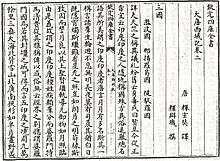Great Tang Records on the Western Regions

The Great Tang Records on the Western Regions (simplified Chinese: 大唐西域记; traditional Chinese: 大唐西域記; pinyin: Dà Táng Xīyù Jì; Wade–Giles: Ta T'ang Hsiyü Chi) is a narrative of Xuanzang's nineteen-year journey through Chang'an to Central Asia and eventually South Asia between 626 and 645. It was compiled in 646[1] by Bianji, a disciple of Xuanzang, who spent more than one year editing the book through Xuanzang's dictation.
Overview
The book contains more than 120,000 Chinese characters and is divided into twelve volumes, which describe the geography, land and maritime transportation, climate, local products, people, language, history, politics, economic life, religion, culture, and customs in 110 countries, regions and city-states from present-day Xinjiang to Persia, Tajikistan, Uzbekistan, Pakistan, India, Bangladesh and Sri Lanka, among other countries.
Importance
Today, the text is of a great value to modern historians and archaeologists.[1] The Records is an important document of Central Asia during the early seventh century, as it provides information of a Buddhist culture existed in Afghanistan during that time and the earliest textual evidence for Buddhist sculptures at Bamiyan.[2] The text also has equal importance in the studies of India, and archaeologists have been using it to fill in certain gaps in Indian history.[1] The book is known for having "exact descriptions of distances and locations of different places",[1] and has served as a guidebook for the excavation of many important sites, such as Rajagrha, the Temple at Sarnath, Ajanta, the ruins of the Nalanda Monastery in Bihar[1] and the ruins of Vasu Bihar of ancient Pundra City. The text inspired Journey to the West, a Chinese novel published in the Ming Dynasty.
| Wikisource has original text related to this article: |
References
Citations
Sources
- Zhu, Yunqiu and Wang, Lixin. Da Tang Xiyu Ji Zhong De Yinduren Xingxiang (The Image of Indians in the Great Tang Records on the Western Regions). Journal of Shenyang University. 2005.2. p. 98-102. ISSN 1008-9225.
- Tang, Qinfu (2001). History of Chinese Historiography. Taiyuan: Shanxi Education Press. ISBN 7-5440-2111-4. p. 230-232.
- Xie, Fang, "Da Tang Xiyu Ji" ("Great Tang Records on the Western Regions"). Encyclopedia of China, 1st ed.
- Zhang Xiuping et al. (1993). 100 Books That Influenced China: Da Tang Xiyu Ji. Nanning: Guangxi Renmin Press. ISBN 7-219-02339-1. p. 392-398.
Translations
- Beal, Samuel (1884). Si-Yu-Ki: Buddhist Records of the Western World, by Hiuen Tsiang. 2 vols. Translated by Samuel Beal. London. 1884. Reprint: Delhi. Oriental Books Reprint Corporation. 1969. Volume 1 (PDF 21.5 MB) Volume2 (PDF 16.9 MB)
- Beal, Samuel (1911). The Life of Hiuen-Tsiang. Translated from the Chinese of Shaman (monk) Hwui Li by Samuel Beal. London. 1911. Reprint Munshiram Manoharlal, New Delhi. 1973. Internet Archive (PDF 14.3 MB)
- Julien, Stanislas, (1857/1858). Mémoires sur les contrées occidentales, L'Imprimerie impériale, Paris. Vol.1 Vol.2
- Li, Rongxi (translator) (1995). The Great Tang Dynasty Record of the Western Regions. Numata Center for Buddhist Translation and Research. Berkeley, California. ISBN 1-886439-02-8
- Watters, Thomas (1904). On Yuan Chwang's Travels in India, 629-645 A.D. Volume1. Royal Asiatic Society, London. Volume 2
External links
- Da Tang Xiyu Ji "Records from the Regions West of the Great Tang Empire" — Chinaknowledge.de.